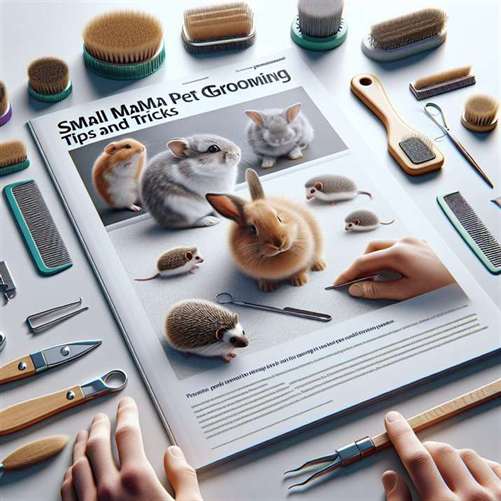Small Mammal Pet Grooming: Tips and Tricks
Introduction
When it comes to caring for our beloved pets, grooming is often an overlooked yet crucial aspect. Small mammal pet grooming plays a vital role in ensuring the health and happiness of our furry friends. Whether you’re the proud owner of a fluffy rabbit, a curious guinea pig, or a playful ferret, understanding the grooming needs of small mammals can significantly enhance their well-being.
Did you know that regular grooming not only keeps your pet looking fabulous but also prevents health issues like matting, skin infections, and even dental problems? A study published in the Journal of Animal Welfare highlighted that pets receiving consistent grooming tend to have lower stress levels and exhibit better behavior. This alone underscores the importance of integrating grooming into your pet care routine.
In this article, we’ll dive deep into the world of small mammal pet grooming. We will explore its significance, best practices, and some handy tips to make the grooming experience enjoyable for both you and your pet. You can expect to learn about specific grooming techniques tailored to various small mammals, the essential tools you’ll need, and how to create a positive grooming environment. If you want to ensure your pets look their best while maintaining their health, keep reading!
To get started, check out our guide on essential pet grooming tools that will equip you for success.
What is Small Mammal Pet Grooming?
Definition
Small mammal pet grooming refers to the practices involved in maintaining the hygiene and appearance of small mammals, including rabbits, guinea pigs, hamsters, and ferrets. Grooming encompasses a variety of tasks that may include brushing, bathing, nail trimming, and dental care. Regular grooming not only helps in keeping your pet clean but also allows you to check for any health issues, such as skin irritations, lumps, or parasites.
Historical Context
The concept of grooming pets dates back centuries. Historically, animals were groomed primarily for practical purposes, such as removing dirt and debris or preparing them for shows. Over time, our understanding of pet care evolved, recognizing grooming as not just a necessity but also a bonding experience between pets and owners.
In recent years, the rise of the pet care industry has brought small mammal pet grooming into the spotlight, with many pet owners seeking professional grooming services. The availability of specialized grooming products and tools has also contributed to the growing trend of at-home grooming, making it accessible for all pet lovers.
The Importance of Small Mammal Pet Grooming
As more people adopt small mammals as pets, the importance of small mammal pet grooming has surged. Here’s why it matters:
- Health Benefits: Regular grooming helps prevent various health issues, such as skin infections, dental problems, and obesity. For instance, rabbits can develop furballs if not brushed regularly, which can lead to serious digestive issues.
- Hygiene: Grooming helps remove dirt, debris, and loose fur, contributing to a cleaner living environment for your pet.
- Bonding Time: Grooming sessions provide an excellent opportunity for you to bond with your small mammal, establishing trust and comfort.
Small Mammal Pet Grooming in the Context of the Pet Care Industry
The pet care industry has seen a significant shift towards comprehensive care for small mammals. Pet owners are increasingly recognizing the importance of grooming, leading to the creation of specialized grooming products and services tailored for small mammals. This shift has also encouraged more veterinary professionals to offer grooming services alongside traditional care.
Key Players or Contributors
Several organizations and individuals have significantly influenced the development of small mammal pet grooming. Pet care brands have invested in creating high-quality grooming products specifically designed for small mammals. Additionally, pet grooming schools and training programs have emerged, equipping aspiring groomers with the skills to handle small mammals safely and effectively.
For more insights into caring for your small mammal, consider reading our complete guide to small mammal pet care.

Benefits of Small Mammal Pet Grooming
Grooming small mammals yields numerous benefits that extend beyond mere aesthetics. Here are some key advantages:
Improved Health
- Skin and Coat: Regular brushing helps maintain coat health by removing dead hair and preventing matting. This is particularly important for long-haired breeds.
- Dental Care: Certain small mammals, like guinea pigs and rabbits, require regular dental care. Grooming sessions can incorporate checking and maintaining their teeth, preventing dental diseases.
- Parasite Prevention: During grooming, you can check for signs of parasites such as fleas or mites, allowing for early intervention and treatment.
Enhanced Behavior
- Stress Reduction: Animals that are groomed regularly often exhibit lower levels of stress and anxiety. Grooming can be a soothing experience that enhances their overall well-being.
- Socialization: Regular grooming instills a sense of routine and familiarity, promoting better social behavior in small mammals.
Stronger Bonds
- Quality Time: Grooming your small mammal provides an opportunity for one-on-one interaction, strengthening your bond and trust.
- Positive Associations: If grooming is done gently and positively, your pet will associate grooming with affection and care, making future sessions easier.
Essential Tools for Small Mammal Pet Grooming
To ensure efficient and effective grooming, it’s essential to have the right tools on hand. Here’s a list of must-have grooming supplies:
Brushes
- Fur Rakes: Ideal for removing tangles and loose fur in long-haired breeds.
- Slicker Brushes: Great for short-haired small mammals, as they effectively remove dirt and debris.
Nail Trimmers
- Guillotine-style Trimmers: Suitable for most small mammals, allowing for precise and safe nail trimming.
- Electric Nail Grinders: These can be quieter and less stressful for some pets, providing a smooth finish.
Bathing Supplies
- Pet-safe Shampoo: Always opt for shampoos specifically formulated for small mammals. Human shampoos can be too harsh.
- Towels: Microfiber towels work best for drying your pet post-bath.
Dental Care
- Dental Chews: These help promote dental health and can be part of your grooming routine.
- Toothbrush and Toothpaste: Specially designed for small mammals, these tools make dental care easier.
Grooming Tables
- Non-slip Mats: Ensure safety and comfort during grooming sessions.
For a deeper dive into the tools you need, visit our page on small mammal pet grooming tips and tricks.
How to Groom Different Small Mammals
Each small mammal has unique grooming needs. Here’s a quick guide on grooming various popular small mammals:
Rabbits
- Frequency: Grooming should be done at least once a week, more often during shedding seasons.
- Technique: Use a slicker brush to remove loose fur. Check ears and nails regularly.
- Bathing: Avoid bathing unless absolutely necessary; it can be stressful.
Guinea Pigs
- Frequency: Every 1-2 weeks for long-haired breeds; less frequently for short-haired ones.
- Technique: Use a wide-toothed comb followed by a slicker brush. Don’t forget to check their teeth!
- Bathing: Only bathe if they become dirty, using a gentle shampoo suitable for small mammals.
Hamsters
- Frequency: Grooming is usually minimal; a quick brush every few weeks suffices.
- Technique: Use a soft toothbrush for brushing their fur; avoid water baths.
Ferrets
- Frequency: Grooming should occur weekly.
- Technique: Use a rubber brush to remove loose fur. Check their nails and ears.
- Bathing: Ferrets can be bathed with ferret-safe shampoo, but it should not be too frequent.
Pet Rats
- Frequency: Grooming is generally not required for rats, but you can help them out when needed.
- Technique: Use a damp cloth to wipe them down if they get dirty.
If you’re looking to adopt a small mammal, consider checking our list of best small mammal pets for families for guidance.
Creating a Positive Grooming Environment
Grooming can be a stressful experience for some pets, but creating a positive environment can make all the difference. Here are some tips:
Choose the Right Location
- Quiet Area: Select a space that’s quiet and free from distractions.
- Comfortable Surface: Use a grooming table or a soft blanket to make your pet comfortable.
Use Positive Reinforcement
- Treats and Praise: Reward your pet with treats and praise during grooming to create a positive association.
- Short Sessions: Keep grooming sessions short, gradually increasing the duration as your pet becomes more comfortable.
Monitor Stress Levels
- Watch for Signs: If your pet shows signs of stress (like biting, scratching, or trying to escape), take a break and try again later.
- Be Gentle: Always handle your pet with care, ensuring their comfort throughout the process.
For more tips on creating a comfortable environment for your small mammal, read our article on [how to improve small mammal pet health](
Resource Links:
- youtube.com: … The ULTIMATE how to give a small dog haircut easy step by step instructions VIDEO!!! From dirty matted dog to complete dog groom and …
- revivalanimal.com: … Revival® Animal Health offers numerous pet grooming clipper … Pet Grooming Tips & Tricks. What is the correct way to groom a dog or …
- youtube.com: … I was always nervous about hitting the quick and my dog just barely tolerates trimming. Now when I’m planning to trim I catch her earlier in the …




0 Comments